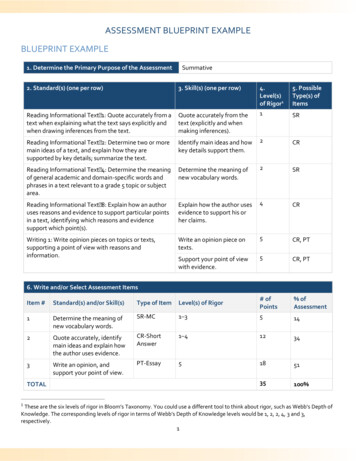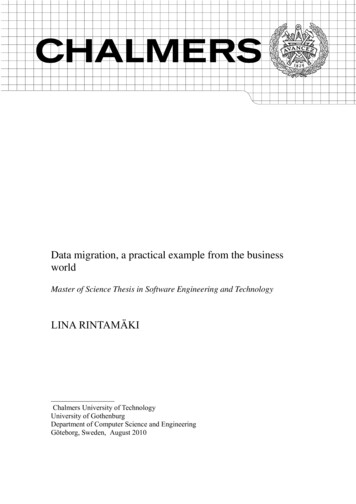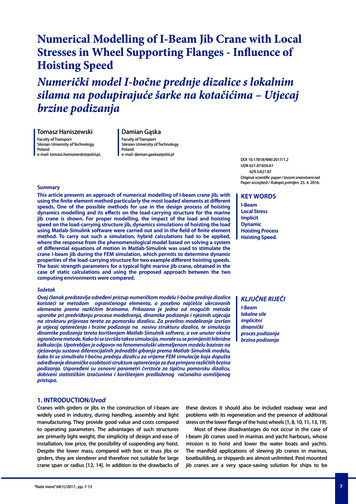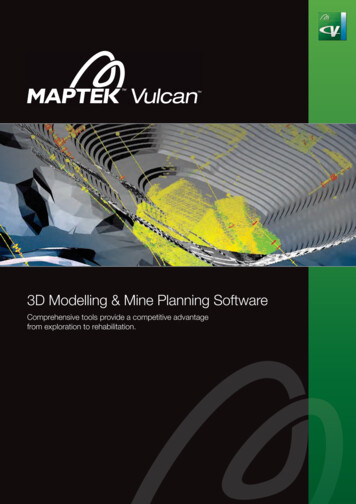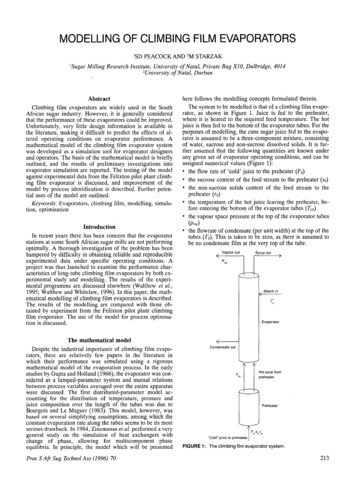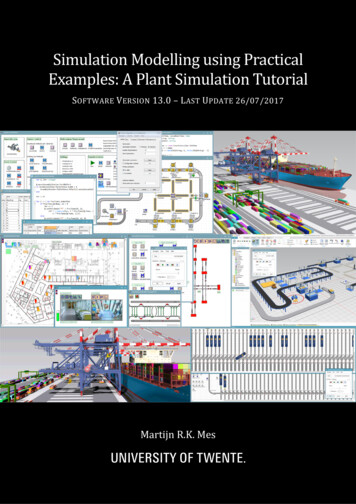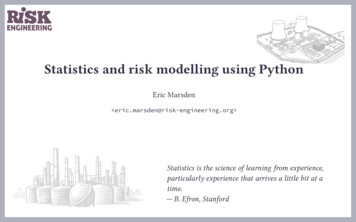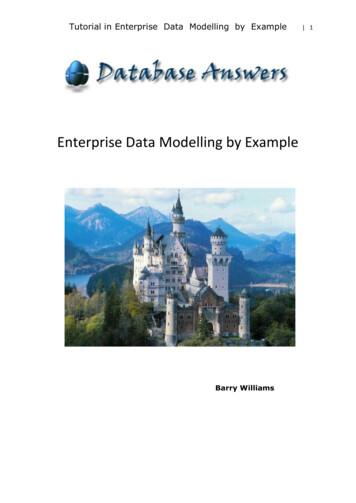
Transcription
Tutorial in Enterprise Data Modelling by ExampleEnterprise Data Modelling by ExampleBarry Williams 1
Tutorial in Enterprise Data Modelling by Example 21. Welcome . 22. Customer Services. 43. Entertainment . 84. Gym Management . 125. Insurance . 156. Investment Banking. 177. Law Enforcement . 238. Local Government . 259. Logistics . 2810.Postal Services . 3111.Retail Business . 3712. Travel and Transport. 4013. Wine. 451. Welcome1.1 IntroductionThis is a collection of Essays on Best Practice in Data Management.Data Management is like a ‘Slowly-Changing Dimension’It changes imperceptibly and then after about a year (on the average) you realize thatthe landscape has changed.Our intention in this book is to capture and define Best Practice at a particular point intime and then keep it up-to-date with new versions of the Book every quarter.1.2 The ApproachUse Horizontal Subject Areas as Design Patterns.These provide generic solutions to commonly occurring situations.Use the Canonical Data Model as an Event-oriented technique and apply it incrementally.
Tutorial in Enterprise Data Modelling by Example 3In each Chapter, we follow our Best Practice sequence of Steps.After reviewing our ten EDMs and completing our ten Chapters, we are in a good position to reviewthe results and determine whether we have validate d our Approach, or whether it needs to bemodified in some way.The Steps are as follows :Step 1. Create a Statement of Business ObjectivesStep 2. Review the Enterprise Data ModelStep 3. Adapt and incorporate Subject Area ModelsStep 4. Review Generic Data MartStep 5. Validate the Canonical Data ModelStep 6. Map to the Canonical Data ModelStep 7. Review Source DocumentsStep 8. Create initial Information Catalogue.
Tutorial in Enterprise Data Modelling by Example2. Customer Services2.1 LinkThe material is shown on this page : http://www.databaseanswers.org/data models/customers and services generic/index.htm2.2 The StepsStep 2. Review the Enterprise Data Model 4
Tutorial in Enterprise Data Modelling by ExampleStep 3. Review Subject Area ModelsCustomers – http://www.databaseanswers.org/data models/retail customers/customers area model.htm 5
Tutorial in Enterprise Data Modelling by ExampleStep 4. Review Generic Data MartThe Data Mart is published on this page : http://www.databaseanswers.org/best practice road map/customer services Data Mart.htm 6
Tutorial in Enterprise Data Modelling by Example 7http://www.databaseanswers.org/data models/customers and products generic/data mart.htmStep 6. Validate the Canonical Data ModelStep 7. Map to the Canonical Data ModelStep 8. Review Source Documents
Tutorial in Enterprise Data Modelling by Example 8Step 9. Create initial Information Catalogue.3. Entertainment3.1 LinkThe material in this Chapter is shown on these pages of our Web Site : http://www.databaseanswers.org/data models/top ten data models ta models/entertainment top level/index.htm
Tutorial in Enterprise Data Modelling by Example3.2 The StepsStep 2. Review the Enterprise Data Model http://www.databaseanswers.org/data models/entertainment top level/index.htm 9
Tutorial in Enterprise Data Modelling by Example 10Step 3. Adapt and incorporate Subject Area Models Cinema Bookings - http://www.databaseanswers.org/data models/cinema bookings/index.htmCircus - http://www.databaseanswers.org/data models/circus/index.htmCity Tourist Guide - http://www.databaseanswers.org/data models/city tourist guide/index.htmThis Model features in our downloadable e-Book entitled “Tourist Guide to London for DataModellers” :o http://www.databaseanswers.org/downloads/Tourist Guide to London for Data Modellers.pdfLicences and Permits - http://www.databaseanswers.org/data models/licences and permits/index.htmMaking a Movie - http://www.databaseanswers.org/data models/movie making/index.htmMaking a Movie (for beginners) –ohttp://www.databaseanswers.org/data models/movie making/making a movie4 beginners.htm
Tutorial in Enterprise Data Modelling by Example 11Step 4. Review Generic Data MartThis Dimensional Model for a Clown Registry is appears on this page : http://www.databaseanswers.org/best practice road map/entertainment Data Mart.htmStep 6. Validate the Canonical Data ModelStep 7. Map to the Canonical Data ModelStep 8. Review Source DocumentsStep 9. Create initial Information Catalogue.
Tutorial in Enterprise Data Modelling by Example 124. Gym Management4.1 LinkThe material in this Chapter is shown on this page of our Web Site : http://www.databaseanswers.org/data models/gym management/index.htmThis Model is an excellent example of our Approach of having a Top-Level Model whichcontains Subject Areas, each with its own Model.4.2 The StepsStep 1. Create a Statement of Business ObjectivesOur Specifications were provided in a question to tour Web Site :“We would please like a schema for or one that will fit the following example or onethat you think could easily adjust to fit from your site to manage and maintain agym membership, facilities and equipment e.g. weight lifting, swimming, boxing etc.covering the braches, facilities, staff, membership, suppliers, parts and repairs. “Step 2. Review the Enterprise Data ModelThis shows the current draft of the EDM :-
Tutorial in Enterprise Data Modelling by Example 13Step 3. Adapt and incorporate Subject Area ModelsWe have a number of Subject Area Data Models on our Web Site.They are featured on this page : http://www.databaseanswers.org/data models/subject area data models.htmHere are the ones that are appropriate to Gym Management : Classes - Workout Programmes Equipment - Maintenance and Repairs Facilities - Subject Area Members - Invoices and Payments and Personal Training Staff - Movements and Museums Suppliers - Procurement
Tutorial in Enterprise Data Modelling by ExampleStep 4. Review Generic Data MartThis Dimensional Model is shown on this page : http://www.databaseanswers.org/data models/gym training diary/data mart.htmStep 6. Validate the Canonical Data ModelStep 7. Map to the Canonical Data ModelStep 8. Review Source DocumentsStep 9. Create initial Information Catalogue. 14
Tutorial in Enterprise Data Modelling by Example 155. Insurance5.1 LinkThis material is available on this page of our Web Site : http://www.databaseanswers.org/data models/enterprise data model for insurance/index.htm5.2 The StepsStep 1. Create a Statement of Business ObjectivesWe start by agreeing a Statement of Business Objectives to establish the scope of the EnterpriseStep 2. Review the Enterprise Data ModelThis EDM is on the page quoted above :-
Tutorial in Enterprise Data Modelling by ExampleStep 3. Adapt and incorporate Subject Area ModelsWe have also created Data Models for these Subject Areas : Customers, Claims and Brokers Personal Insurance, Claims and Payments Types of Insurance - Car, Home and Life Types of Insurance - Marine and Motor VehiclesStep 4. Review Generic Data MartStep 6. Validate the Canonical Data ModelStep 7. Map to the Canonical Data ModelStep 8. Review Source DocumentsStep 9. Create initial Information Catalogue. 16
Tutorial in Enterprise Data Modelling by Example 176. Investment Banking6.1 LinkThis material is available on this page of our Web Site : http://www.databaseanswers.org/data models/enterprise data model for investment banks/marketing pack for investment banking.htm6.2 The StepsThe results of applying the Steps are as follows :Step 1. Create a Statement of Business ObjectivesWe start by agreeing a Statement of Business Objectives to establish the scope of the EnterpriseData Model.Once we have agreed the Statement of Business Objectives we can create a draft Top-Level Modelwith associated Subject Areas, each of which is shown in its own Model.This is an example of a Statement of Business Objectives for an Investment Bank :"Our Business objectives are to offer a range of Services to Clients, which can be either organizationsor High-Net-Worth Individuals.These Services will involve completing Deals for our Clients in which our Staff will participate withthe purpose of achieving acceptable returns on investment.Brokers may participate in these Deals, which will all be completed by Settlements.Deals may involve multiple Currencies and incur subsequent Transactions, such as adjustments.The Enterprise Data Model will establish the data available for a Data Warehouse to meet BusinessIntelligence requirements.
Tutorial in Enterprise Data Modelling by Example 18Step 2. Review the Enterprise Data ModelAfter we have agreed the Statement of Business Objectives with the business we canreview our Enterprise Data Model.This will establish the data available for Data Marts to meet Business Intelligencerequirements.We can adopt an approach geared to a Product Lifecycle (Buy and Sell) or to a Customer(Engage, Service, Disengage) or KPI-related, or some combination of these.Step 3. Adapt and incorporate Subject Area ModelsWe have also created Data Models for these Subject Areas : Accounts Brokers Customers/Clients Deals Deals FX Deals (General) Financial Products FpML Products FpML Products Data Model
Tutorial in Enterprise Data Modelling by Example Key Performance Indicator (KPI) Settlements Staff Transactions Other Subject AreasStep 4. Review Generic Data MartThis is :- 19
Tutorial in Enterprise Data Modelling by ExampleFor Investment Banking, we have also created this Data Mart for a KPI which monitors TotalSettlements Amounts by Currencies. :-Step 5. Validate the Canonical Data Model 20
Tutorial in Enterprise Data Modelling by ExampleStep 7. Map to the Canonical Data ModelThis is an example of mapping to the Canonical Data Model.Step 8. Review Source DocumentsThis is an example of an Client Asset Holding Weekly Report. 21
Tutorial in Enterprise Data Modelling by Example 22Step 9. Create initial Information Catalogue.This is an example of an Operational Data Store that shows the data in a typical SourceDocument.We can use this to create our initial Information Catalogue.
Tutorial in Enterprise Data Modelling by Example 237. Law Enforcement7.1 LinkThe material in this Chapter appears on this page : http://www.databaseanswers.org/data models/top ten data models law enforcement.htm7.2 The StepsWe also have a Tutorial for MDM in Law Enforcement : http://www.databaseanswers.org/tutorial4 mdm in law enforcement/index.htmThe Steps are as follows :Step 1. Create a Statement of Business ObjectivesStep 2. Review the Enterprise Data ModelThe Police Generalised Data Model : http://www.databaseanswers.org/data models/police generalized data model/index.htmAlso check out the associated Tutorial : http://www.databaseanswers.org/data models/police generalized data model/facts.htmStarts here :“The Area being Modelled is :A Generalised Database for any Police ServiceSource material for this work was originally taken from the UK Pito Corporate Data ModelA. THE USER REQUIREMENTS :A Generalised Database that will apply to any Police Force, anywhere in the world.B. THE APPROACH :The Approach was to start with the Generic Data Model for Organisations and People,and map the Police Force Database on to this Data Model.Details of Entity Mappings are contained in this Table.
Tutorial in Enterprise Data Modelling by ExampleOrg and People Model Police Model 24CommentAccountCalendarEasily added to Org & PeoplePartyAssetVehicleEventBusiness ActivityOrganisationOrganisationPeoplePersonAnd ends here *****************Step 3. Adapt and incorporate Subject Area Models Fingerprint Recognition - http://www.databaseanswers.org/data models/fingerprint recognition/index.htmForensic Science Labs - http://www.databaseanswers.org/data models/forensic science labs/index.htmGlobal Crime - http://www.databaseanswers.org/data models/global crime/index.htmPolice Departments - http://www.databaseanswers.org/data models/police departments/index.htmPrisons and Prisoners - http://www.databaseanswers.org/data models/prisons and prisoners/index.htmTracking Evidence - http://www.databaseanswers.org/data models/tracking evidence/index.htmStep 4. Review Generic Data MartThis is a Data Mart for Traffic Cops and Tickets :-
Tutorial in Enterprise Data Modelling by ExampleStep 6. Validate the Canonical Data ModelStep 7. Map to the Canonical Data ModelStep 8. Review Source DocumentsStep 9. Create initial Information Catalogue.8. Local Government8.1 LinkThe material in this Chapter appears on this page : http://www.databaseanswers.org/data models/enterprise data model for local government/index.htm8.2 The StepsStep 2. Review the Enterprise Data ModelThis Model is on this page :- 25
Tutorial in Enterprise Data Modelling by Example http://www.databaseanswers.org/data models/enterprise data model for local government/index.htmStep3.Adaptand incorporate Subject Area ModelsWe have also created Data Models for these Subject Areas : Children's Attainments Citizens Citizens and Addresses Services Customers and Services Education Services Housing ServicesStep 4. Review Generic Data MartThis Model needs replacing. 26
Tutorial in Enterprise Data Modelling by Example 27
Tutorial in Enterprise Data Modelling by Example 289. Logistics9.1 LinkThe material in this Chapter appears on this page : http://www.databaseanswers.org/data models/enterprise data model for logistics/index.htm9.2 The StepsThe Steps are as follows :Step 1. Create a Statement of Business ObjectivesStep 2. Review the Enterprise Data ModelStep 3. Adapt and incorporate Subject Area ModelsStep 4. Review Generic Data MartStep 6. Validate the Canonical Data ModelStep 7. Map to the Canonical Data ModelStep 8. Review Source DocumentsStep 9. Create initial Information Catalogue.
Tutorial in Enterprise Data Modelling by Example 29Step 2. Review the Enterprise Data ModelThis Data Model is available on this page : http://www.databaseanswers.org/data models/enterprise data model for logistics/index.htm
Tutorial in Enterprise Data Modelling by ExampleStep 3. Adapt and incorporate Subject Area ModelsStep 4. Review Generic Data MartThis Data Mart has been named according to the style recommended byPragmatic Works where Dimension and Fact Tables are named appropriately. 30
Tutorial in Enterprise Data Modelling by Example 3110.Postal Services10.1 LinkThe material in this Chapter appears on this page : http://www.databaseanswers.org/data models/postal services/index.htm10.2 The Steps.Step 1. Create a Statement of Business ObjectivesOur main sources of information is the TNT Post Web Site.We find that one of the Services they offer is TrackingOur first thought as outsiders who have sent and received post is that the business delivers letters,packages and parcels to an Address for a fee.We decide to call these Things of Interest ‘Deliverables’.We look for some kind of "Business Mission Statement" that can help us to derive a Top-Level viewof the business.We find this statement on the Web Site :"TNT Post is the Royal Mail's number one challenger for business mail of all kinds.Whether we're handling your letters, packets and parcels or successfully managing yourunaddressed doordrop strategy, you'll find we're straight-talking people who get the job done.Our can-do approach and our focus on efficiency make us different, saving you time and money.We provide a high quality, full service concept for all your business mail and distribution needs.Our portfolio is designed to deliver what you want. We are confident that we can meet your postalservice requirements and exceed your expectations, whatever the scale and scope of yourenterprise.”On the Web Ste, we see an option for Customers to register Complaints.We decide to model that as a more general Feedback facility, to include Compliments andSuggestions.At this point, we can say that the Things of Interest are .Distribution Centres (the mail has to be stored somewhere)
Tutorial in Enterprise Data Modelling by Example6.7.8.9.10.11. e Organisation offers Services, which include :1.Deliver items.2.Receive Payments3.Publish Schedules4.Agree Contracts with CustomersAt this point, we can create our first draft of the Top-Level Data Model.We will need to decide what our Subject Areas are going to be.Then we will need to review our first draft with the Review Committee of business users.Finally, we define the Business Data Rules.Now that we have defined the 'Things of Interest' we can establish how they are related.We call these the 'Business Data Rules' and then we review the with our Steering Groupand modify them as required.1. A Customer always signs one or more Contracts for Services.2. Customers can post Deliverables in line with the terms of a Contract.3. The Postal Company provides Services that deliver Deliverables according to theterma of a Contract.Step 4. Identify the Reference DataThe Reference Data is important because it provides the Foundation for all the otherData.
Tutorial in Enterprise Data Modelling by ExampleStep 2. Create the first draft Enterprise Data ModelThis is our first Version :- 33
Tutorial in Enterprise Data Modelling by ExampleThe following day, I reviewed the Web Site in more detail and here is my second Version :- 34
Tutorial in Enterprise Data Modelling by Example 35Step 3 : Incorporate Subject Area ModelsWorking from this second Version, I located some appropriate Subject Area Models in my Library : http://www.databaseanswers.org/data models/subject area data models.htmSubject Areas are : Contracts Customers Customer and Addresses Deliveries (Schedules) Feedback Invoices and Payments Staff Vehicle Maintenance and Tracking
Tutorial in Enterprise Data Modelling by ExampleStep 4. Create a Data MartWe are now in a position where we can create design for the Data Mart :-Step 5. Validate the Canonical Data ModelStep 6. Map to the Canonical Data ModelStep 7. Review Source DocumentsStep 8. Create initial Information Catalogue. 36
Tutorial in Enterprise Data Modelling by Example11.Retail Business11.1 LinkThe material in this Chapter appears on this page : http://www.databaseanswers.org/data models/enterprise data model for retail/index.htm11.2 The Steps.Step 1. Create a Statement of Business ObjectivesThe Specifications are available for review.We start by agreeing a Statement of Business Objectives to establish thescope of the Enterprise Data Model.Once we have agreed the Statement of Business Objectives we can create adraft Top-Level Model with associated Subject Areas, each of which is shown inits own Model.This is an example of a Statement of Business Objectives for a Retailorganization :"Our Business objectives are to offer a wide range of affordable Products.We will control costs to achieve maximum profit potential from a wide range ofaffordable Products which are sourcedon a 'just-in-time' basis tailored to our target market, with specific Customerprofiles.The Enterprise Data Model will establish the data available for a DataWarehouse to meet Business Intelligence requirements."This Data Model is a variation of the Retail Customers Model.The Specifications are available for review.We start by agreeing a Statement of Business Objectives to establish the scopeof the Enterprise Data Model.Once we have agreed the Statement of Business Objectives we can create adraft Top-Level Model with associated Subject Areas, each of which is shown inits own Model.This is an example of a Statement of Business Objectives for a Retailorganization :"Our Business objectives are to offer a wide range of affordable Products. 37
Tutorial in Enterprise Data Modelling by ExampleWe will control costs to achieve maximum profit potential from a wide range ofaffordable Products which are sourced on a 'just-in-time' basis tailored to ourtarget market, with specific Customer profiles.The Enterprise Data Model will establish the data available for a DataWarehouse to meet Business Intelligence requirements."Step 2. Review the Enterprise Data ModelThis EDM is a variation of the Retail Customers Model and appears on this page –ohttp://www.databaseanswers.org/data models/enterprise data model for retail/index.htmStep 3. Review the Subject Area Models Customers Subject Area Customers and Orders In-Store Shopping Online Shopping Order History Products Subject Area Products, Stores and Sales Subject Area Registered Users (with MDM Customer Master Index) 38
Tutorial in Enterprise Data Modelling by Example 39Step 4. Review Generic Data Mart http://www.databaseanswers.org/data models/enterprise data model for retail/retail customers data mart.htmStep 6. Validate the Canonical Data ModelStep 7. Map to the Canonical Data ModelStep 8. Review Source Documents
Tutorial in Enterprise Data Modelling by Example 40Step 9. Create initial Information Catalogue12. Travel and Transport12.1 LinkThe material for this Chapter has been taken from this page on our Web Site which covers travel byTrains, Boats and Planes: http://www.databaseanswers.org/data models/trains and boats and planes/index.htmAdditional material for specific modes of Travel appears on this page : http://www.databaseanswers.org/data models/top ten data models transport and travel.htm12.2 The Steps.There are three sections in this Chapter : Air Travelo http://www.databaseanswers.org/data models/enterprise data model for air travel/index.htmShippingo http://www.databaseanswers.org/data models/container shipping/index.htmTrain Travelo http://www.databaseanswers.org/data models/train ticketing systems/index.htmThe Steps are as follows :Step 1. Create a Statement of Business Objectives
Tutorial in Enterprise Data Modelling by ExampleStep 2. Review the Enterprise Data ModelThis shows the current state of our Third-Normal Form Data Model :- 41
Tutorial in Enterprise Data Modelling by Example 4212.2.1 Air TravelStep 3. Adapt and incorporate Subject Area Models3.1 Subject Area for Air TravelThis Model appears on this page for an Enterprise Data Model for Air Travel : http://www.databaseanswers.org/data models/enterprise data model for air travel/index.htm
Tutorial in Enterprise Data Modelling by Example3.1.1 Detailed Subject Area for Air TravelWe have also created Data Models for these Subject Areas : Aircraft Maintenance Airline Operations Airline Reservations Airport Management Passengers Online BookingsStep 4. Review Generic Data MartStep 6. Validate the Canonical Data ModelStep 7. Map to the Canonical Data ModelStep 8. Review Source DocumentsStep 9. Create initial Information Catalogue. 43
Tutorial in Enterprise Data Modelling by Example 4412.2.2 ShippingYou can download our short Discussion Paper on Enterprise Data Modelling for Container Shipping http://www.databaseanswers.org/data models/container shipping/Discussion Paper on Enterprise Data Model.pdfStep 3. Review the Subject Area Models for Shipping12.2.2.1 Top-Level Model for ShippingThis Model appears on this page for the Top-Level Data Model for Container Shipping : http://www.databaseanswers.org/data models/container shipping/index.htm1.2.2.2.2 Subject Area Models for ShippingContainers http://www.databaseanswers.org/data models/container shipping/subject area for containers.htm Data Mart –ohttp://www.databaseanswers.org/data models/container shipping/data mart.htm
Tutorial in Enterprise Data Modelling by Example 4512.2.3 Train TravelStep 3. Adapt and incorporate Subject Area Models3.1 Subject Area for Train Travel Public Transporto http://www.databaseanswers.org/data models/public transport/index.htmData Mart for Public Transport :o http://www.databaseanswers.org/data models/public transport/public transport data mart.htmRailway Reservations –o http://www.databaseanswers.org/data models/railway reservations/index.htmTrain Systems :o http://www.databaseanswers.org/data models/train system map/index.htmTrain Ticketing Systems :o http://www.databaseanswers.org/data models/train ticketing systems/index.htm13. Wine13.1 LinkThe material in this Chapter appears on this page : http://www.databaseanswers.org/data models/enterprise data model for wine/index.htm13.2 The StepsStep 2. Review the Enterprise Data Model
Tutorial in Enterprise Data Modelling by ExampleStep 3. Review Subject Area ModelsWe have created Data Models for these Subject Areas :These Models have been combined in the Enterprise Data Model. Wine Cellars Wine Food and Merchants Wine Food and Pairings Wine ListsLink to Wine Cellars Data Model : http://www.databaseanswers.org/data models/wine cellars/index.htm 46
Tutorial in Enterprise Data Modelling by ExampleWine, Food and Merchants : http://www.databaseanswers.org/data models/wine food and merchants/index.htm 47
Tutorial in Enterprise Data Modelling by ExampleWine, Food and Pairings : http://www.databaseanswers.org/data models/wine food and pairings/index.htm 48
Tutorial in Enterprise Data Modelling by ExampleWine Lists : http://www.databaseanswers.org/data models/wine lists/index.htmStep 4. Review Generic Data MartStep 5. Validate the Canonical Data ModelStep 6. Map to the Canonical Data ModelStep 7. Review Source DocumentsStep 8. Create initial Information Catalogue 49
Tutorial in Enterprise Data Modelling by Example 50Appendix A. Cloud MigrationThis Approach to Enterprise Data Modelling can provide avery powerful technique for migrating to a Data Architecture that incorporates Cloud features.This page shows the appropriate Data Architecture : http://www.databaseanswers.org/reference data architecture.htmThe Enterprise Data Model (EDM) is used for the Data Warehouse and Data Marts.The Master and Reference Data will be in the Clouds And will form the foundation and will becompliant with the EDM.
Tutorial in Enterprise Data Modelling by Example 18 Step 2. Review the Enterprise Data Model After we have agreed the Statement of Business Objectives with the business we can review our Enterprise Data Model. This will establish the data available f
